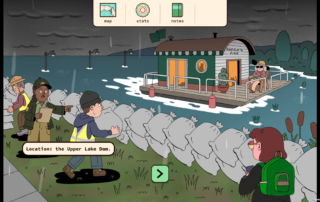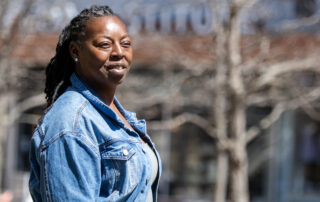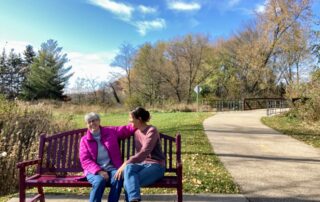With backpacks slung over their shoulders and digital cameras hanging from their necks, a group of about twenty teens trek through the forests of the St. Croix National Scenic Riverway.
Like many people who visit these woods, the teens come in need of healing and refuge from difficult lives, lives that include:
“Breaking into cars, my anger, my depression …”
“Drug issues …”
“Trouble in school, trouble with the law …”
“The one thing that they have in common is that, for one reason or another, they’ve lost hope in their lives,” said Ben Thwaits, one of their teachers at Northwest Passage, a residential treatment center in Northern Wisconsin. “The majority are referred through like the county juvenile justice system … but a fairly decent percentage are also referred through families.”
Thwaits began teaching at Northwest Passage after working for two years as a nature photographer.
“Being a nature photographer is still a really core piece of who I am, and when I started my job at northwest passage as a teacher, I was always looking for ways to get nature photography into the classroom,” Thwaits said.
Eventually, Thwaits sought a grant from the National Parks Foundation to buy a handful of sophisticated digital cameras for his students. Teaching them the basics of photography, Thwaits took the students and their cameras into the forest.
“They started taking truly astonishing photos,” Thwaits said. “Within probably three or four weeks, we realized that we were onto something real special, because these kids started investing into their photography on a level way beyond anything I’d ever seen at any other school program.”
Thwaits called his new program “In a New Light.” As the program grew, the students’ photographs gained more and more attention: going on display at sporting events, state capitols, and national parks. With help from the National Parks Foundation, the students have travelled beyond Wisconsin to other National Parks on photography expeditions.
On this day, though, the students are working in a dry creek bed near the St. Croix River. Some climb the bluffs to photograph ferns and rocks while others explore the fallen leaves and wildflowers growing in the mud below. The students say these photographs are a way to share what they feel.
“It’s a way to express myself without actually talking to people, because sometimes I don’t like talking to people,” said a student named Michelle.
“Just being able to express yourself, share your vision with the world,” said another student named Adam.
“These pictures can be a door through which they can access their feelings, their hopes, their struggles, and to process their lives in a way that’s way different than a therapist’s couch,” said Thwaits.
Along with their pictures, these students have also begun expressing themselves in poems about their photographs.
“I feel that this fish is like my little brother / Always smiling and probably love his mother / One day this fish will end up in heaven / So will I. We’ll be there together,” wrote a student named Jamahri about a picture of a fish.
“Sometimes the only thing that can make you happy is a plain flower / You just need to view it in a special way and turn it into your sunny day,” wrote another student about a photograph of a flower.
“When I was a little kid, I used to see water push on rocks. When my mom and I were at the bridge, my mom said she wouldn’t let me fall,” wrote a student named Michael about a picture of a rocky waterfall.
The students’ photographs and poems are now on permanent display at the In a New Light gallery in Webster.
“We make a very conscientious effort to share their work with the world, keeping in mind that most of these young men and women have never been recognized for anything positive that they’ve ever done,” Thwaits said. “The only recognition that they’ve got has been for things that they’ve done wrong.”
In fact, Thwaits wonders whether the traits that cause these students to stumble are the same traits that cause their work to shine.
“They’re … risk-takers. They’re sensation-seekers. They don’t necessarily respect convention,” Thwaits said. “But if you think of … the traits of great artists … they’re risk-takers, they’re sensation-seekers, they don’t care what people think. They don’t necessarily respect convention. We’re figuring out a way to harness the inherent characteristics in so many of these kids and translate them into a very positive outlook.”
For more information on the program and to see some of the incredible photographs produced by Ben and his students visit In a New Light’s website.










